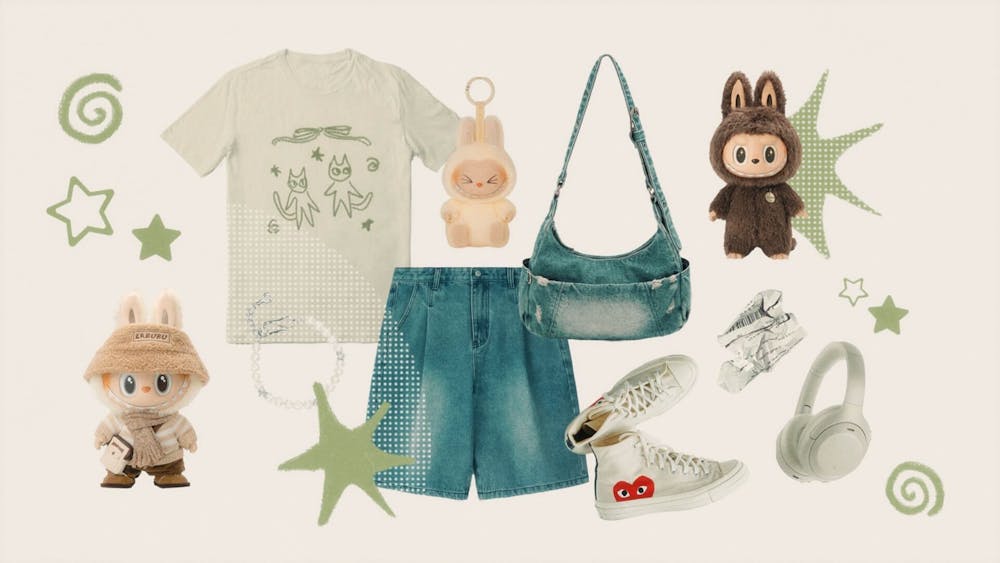Bags adorned with fuzzy creature keychains have become a common sight lately, signaling one of 2025’s most sought-after accessories. With their colorful fur, creeping smile, and bunny ears, the collectible Labubu monster figurines originated in Hong Kong and are made by the company Pop Mart. What started as a niche collectible has escalated into another charming symptom of aesthetic culture. So, what’s the hype? The appeal is part scarcity, part surprise. As they are incredibly difficult to acquire, finding these little monsters in stores and online is exciting. Adding to the subterfuge, they come in blind boxes: you never know what design you are about to get unless you purchase and open the product; scoring your favorite Labubu becomes a game of luck, even if it means requires purchasing multiple boxes at a time. As this trend gains momentum, it has integrated into other aspects of pop culture, particularly fashion and style.
While scrolling on TikTok, it’s easy to encounter videos of influencers styling their outfits to match their Labubus. Their clothing perfectly complements the colorful keychain stacks, making for cohesive and aesthetic looks. But this fusion of style and collectible culture isn’t new. Take Sonny Angels, for example. In 2023, many individuals fell in love with plastic angel figurines donned in themed costumes (such as the Vegetable, Flower, and Animal Series). The brand’s Hipster series even included spots for adhesive strips so that individuals could attach them to phone cases, computer screens, and car mirrors. Cute? Yes. But more than that, the items became accessories and wearable identity markers—a new way to spice up outfits and strengthen the buyer’s preexisting aesthetics.
That said, the mass market frenzy over these figurines raises pressing concerns. As collectibles like Labubus become fashion must–haves, they pile on to fast fashion heap—cheap, mass produced, and sold at relatively low price points. The clothing is usually geared towards the current micro trends (trends happening in the fashion industry for a short period of time) through their quick manufacturing and large–scale distribution—which contributes to high amounts of waste in landfills. In this case, one might argue that consumers are merely chasing a micro-trend—mindlessly purchasing these trinkets to ride the wave of fleeting hype, only to discard them once the next 'new' and 'shiny' obsession takes hold. For those who purchase many over the course of the trend’s life cycle, the habit could easily become unsustainable. The labelling of these products as collectors item builds up sentimental value amongst purchasers. It takes time, effort, and money to find and acquire these items. Whether it’s the thrill of unboxing the exact trinket you wanted or the disappointment of pulling a duplicate, the experience creates memories that stick.
Additionally, the parallels between today’s Labubu craze and the earlier Sonny Angels phenomenon suggests that these trends may not disappear as quickly as people think (even Calico Critter figurines are making their return to pop culture). Although it has been a couple of years since Sonny Angels “blew up” on social media, they consistently remain sold out in stores and online—a clear indicator that their popularity reigns on, despite not being the hottest collectible on the market right now. As a Sonny Angels collector myself, I can confirm: the thrill doesn’t wear off. Constantly on the hunt, searching bookstores and trinket shops throughout Philadelphia and near my hometown, the urge is inevitable.
Although popular collector's item trends promote cyclical consumption patterns, the tendency of individuals to ascribe sentimental value to these objects may partially offset their disposability, creating a countervailing force against pure trend–driven waste. Of course, that is yet to be seen of every owner of a Labubu or a similar product; who may view these objects as temporary possessions. These situations pose dangers to the environment—particularly with excess waste and the depletion of resources. Ultimately, there will always be something new and trendy on the market. That doesn’t mean we need to chase it all. At some point, we have to ask ourselves what we're actually gaining by keeping up—whether it’s style, connection, or just the fleeting comfort of peeling back the plastic wrapping. Trends can be fun, even meaningful, when approached with intention. There’s nothing wrong with joining viral trends—as long as we do so consciously, balancing participation with mindful consumption.
They might not be the hottest mainstream trend in a couple of months, but for many, Labubu dolls have captured more than just curiosity. The adorable monsters bring happiness to all who find them, excitement to those who seek them, and fun, expressive ways to expand personal style—accessorizing the wardrobes of those who own them.







